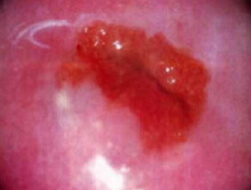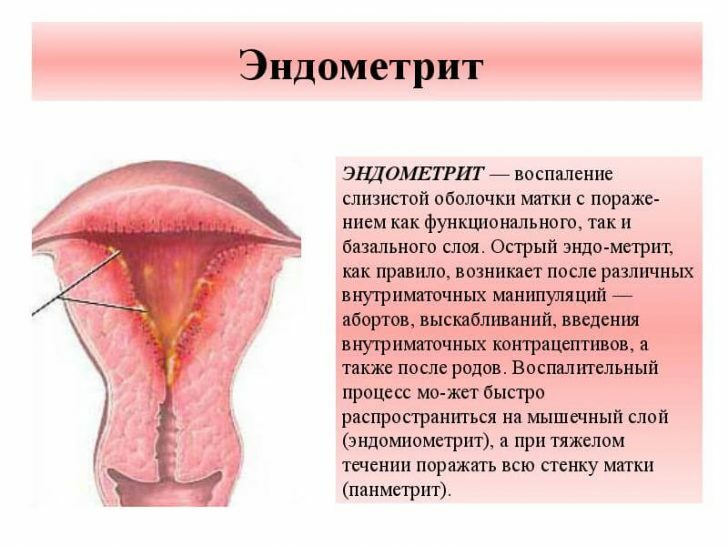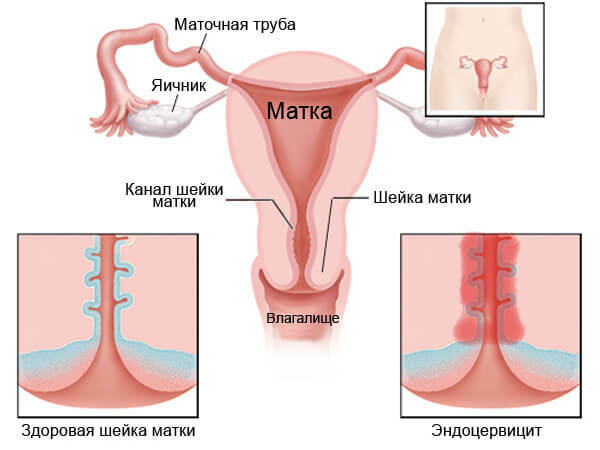Cervical Ectopy
 Ectopia of the cervix is the presence on the surface of the cervix of the epithelium, which should be located in the cervical canal. Literally "ectopia" means "outside", with reference to the cervix, this term is used when the borders of the cylindrical epithelium shift from the cervical canal to the surface, and instead of being inside, part of the mucous cervical canal is outside. As a result, on the cervix of the uterus, there is a delimited segment of the mucosa accessible to the external examination, different from the surrounding epithelium by appearance and structure.
Ectopia of the cervix is the presence on the surface of the cervix of the epithelium, which should be located in the cervical canal. Literally "ectopia" means "outside", with reference to the cervix, this term is used when the borders of the cylindrical epithelium shift from the cervical canal to the surface, and instead of being inside, part of the mucous cervical canal is outside. As a result, on the cervix of the uterus, there is a delimited segment of the mucosa accessible to the external examination, different from the surrounding epithelium by appearance and structure.
Ectopia of the epithelium of the cervix of the uterus, more precisely - the ectopy of the cylindrical epithelium, for many years belongs to the most common conditions in gynecology. Its presence is diagnosed in 40% of women, and among those who have gynecological pathology, ectopia is present in every second.
There are several misconceptions related to ectopia of the cervix, which must be refuted:
- Ectopy occurs on the cervix after the onset of sexual activity. Indeed, the presence of ectopy is diagnosed only with visual examination, when it is possible to insert mirrors in the vagina and examine the surface of the cervix, which is very difficult in the presence of a hymen. However, the ability to see the area of the cylindrical epithelium on the neck does not mean that the ectopy provokes sexual intimacy, which is confirmed by the presence of congenital and hormonal-dependent forms of ectopia in girls.
- Cervical Ectopy is always a disease. And this statement is incorrect, since this peculiarity of the location of the cylindrical epithelium on the neck can refer to the physiological norm, for example, the congenital ectopia of the cervix or the uncomplicated form of acquired ectopy occurring in 11.3% of girls.
The ectopia that appeared on the cervix during pregnancy is also associated with the physiological state, since it is associated with natural hormonal changes.
As a disease, only the acquired symptomatic ectopia of the cervix is considered, coupled with complications.
- Erosion and ectopia of the cervix are equivalent concepts. Also an incorrect statement. The true erosion of the cervix always implies the presence of a wound, that is, a violation of the integrity of the mucosa that covers the cervix. Ectopy is not an injury, the neck surface is not damaged in this condition.
- Ectopia of the cervix always appears after delivery. Statistics state that half of all diagnosed ectopy falls on nulliparous young( under 25 years) women.
- Ectopia must be treated. Congenital ectopia of the cervix, as well as uncomplicated forms of the acquired one, need only observation.
- Ectopia is related to cancer. For many years, ectopic cervix was actually classified as a precancerous process, and later it was reliably proven to be of good quality.
There are many reasons for the appearance of acquired ectopia, but more often it is the result of infectious inflammation, mechanical damage to mucous membranes, or a joint effect of these factors.
Ectopy is usually present on the neck asymptomatically, except for the extensive ectopia of the cervix, which can provoke minor contact spotting outside menstruation and abnormal leucorrhoea. All complaints of patients with ectopy often correlate with the concomitant infectious-inflammatory process( colpitis, cervicitis) or hormonal dysfunction.
There is no comprehensive answer to the question of how the ectopia of the cylindrical epithelium is formed, because the same provoking mechanisms lead to the appearance of ectopia in not all patients.
With visual examination, the ectopia of the cervix has the appearance of a red spot of various shapes and sizes. More detailed information on the nature of structural disorders in the zone of ectopy is obtained by colposcopic and cytological examination.
The need for the treatment of congenital and uncomplicated forms of ectopy occurs only in the case of complications, and before they appear behind the epithelium, the cervix is regularly observed.
The complicated form of any ectopia is an indication for mandatory treatment. The basis of all the numerous methods of treatment is the destruction( destruction) of a portion of the cylindrical epithelium.
Causes of cervical ectopy
The neck surface, like the vaginal cavity, is lined with several layers of epithelial cells of flat shape( multilayered flat epithelium).The cavity of the cervical canal is lined with a single mucous layer, the cells of which have a cylindrical shape( single-layered cylindrical epithelium).Usually the area of the cervix, where these two kinds of epithelium occur, is located inside the external pharynx( physiological narrowing of the canal before its connection with the vaginal cavity).It is called a zone of transformation and is not accessible to a simple survey. When the cylindrical epithelium "slides" from the cervical cavity beyond the boundaries of its normal location, it causes the transformation zone to shift, allowing the ectopic to be detected visually.
Mechanisms for the formation of an area of ectopia on the cervix are not fully understood. Congenital ectopia of the cervix can probably be a consequence of an incorrect differentiation of the epithelium into a flat and cylindrical one, when this differentiation is ahead of the formation of the rest of the neck tissue. Such a process can be considered as a physiological state. Also, the presence of cylindrical epithelium outside the outer throat in children, small girls and adolescents is due to a deficiency of estrogenic influence on the tissues of the genitalia that form. At the end of the period of sexual development, when the ovaries begin to function fully, this border can move to the "proper" place, and ectopy is no longer visible, therefore congenital ectopia is considered to be the only form that does not exclude spontaneous healing.
With estrogen deficiency, not only the ectopia of the cervical epithelium of the early reproductive period is associated. Hormonal origin has ectopia of the cervix in pregnant women.
Congenital ectopia is considered a temporary physiological condition, and the acquired form is always provoked by negative factors. The most popular of them are:
- Infectious-inflammatory process, including sexual infections. The close anatomical and functional connection of the external genitalia causes the appearance of joint inflammation in the vaginal mucosa and cervix. The most aggressive effect on the cervical epithelium is provided by representatives of a specific microflora: gonococci and Trichomonas. Infection damages the epithelium of the cervix, which can later regenerate incorrectly.
- Disordered sexual intercourse without proper contraception. They not only increase the chance of the appearance of ectopia on the cervix, but also lead to other negative consequences - unwanted pregnancy, chronic infectious diseases, infertility.
- Multiple mechanical damages of the cervix in the process of traumatic births, abortions.
- Hormonal dysfunction( disorders of the menstrual cycle), resulting in an inadequate hormonal effect on the cervical epithelium.
- Early( before 18 years) sexual debut and the same early births, capable of traumatizing the tender mucous cervix of the uterus, in addition, the early reproductive period is characterized by imperfect hormonal regulation, which also favors the appearance of ectopia.
Symptoms and signs of cervical ectopy
There are no specific symptoms indicating ectopy. As a rule, all clinical manifestations are associated with concomitant disease and refer to complicated ectopia of the cervix.
Asymptomatically, only uncomplicated ectopy is present asymmetrically on the cervix. It is discovered accidentally on examination, so it is often impossible to determine exactly from what point it exists on the neck. Probably, most uncomplicated asymptomatic ectopias are present at birth. There is an opinion that congenital ectopia disappear on their own until their detection, so the number of diagnosed cases is small( 11.3%).
Acquired ectopia of the cervix is diagnosed more often, and more than 80% of cases it is complicated. With a complicated form, ectopia is accompanied by a local inflammatory process, so the clinical manifestations are determined by the nature of the infection. The patient is disturbed by pathologically abundant serous or serous-purulent vaginal discharge, itching, and urination disorder. Extensive ectopia of the cervix sometimes provokes minor contact bleeding.
Ectopia of the cervix after birth can be asymptomatic. Sometimes the existing clinical manifestations are masked by postpartum symptoms( leucorrhoea, lochia), so the diagnosis of cervical ectopy in the delivery of the mother is placed on during routine examination.
Complaints by patients on the change in the nature of menstrual function and reproductive problems indicate a link between cervical ectopia and hormonal dysfunction.
Detect ectopia of the cervix allows a normal gynecological examination. The multilayered epithelium covering the cervix is colored pale pink. The mucous membrane of the cervical canal has a single-layer structure, so through her translucent underlying tissues and blood vessels, which gives it a red hue, so when viewed from the neck of a well visualized demarcated red stain on a pale pink background, in most cases the surrounding cervical canal outside.
If the inflammatory process is present in the vagina, all signs of infection - redness, swelling, abundant leucorrhoea on the walls of the vagina and the cervical surface are additionally diagnosed.cervical ectopia with signs of infection always looks brighter, it can be covered with a purulent coating, and its dimensions in a simple examination to determine reliably the difficult due to the pronounced inflammation and swelling of the surrounding tissue.
It is impossible to establish the diagnosis of ectopia of the cervix visually, since the external signs of ectopia are difficult to distinguish from other pathologies of the cervical epithelium. See the nature of the changes in the structure of multilayer epithelium possible with colposcopy. Multiple increase of the optical device( colposcope) allows more detailed examination of the "spot" on the cervix, its surface and texture.
Sometimes it is difficult to see the true dimensions and outlines of the site of ectopy. During colposcopy their "isolated" with acetic acid solution, it stimulates vasoconstriction and, as a result, change in color and texture ectopia: on the neck become visible pale glassy growths columnar epithelium resembling grape.
When studying the area of ectopic cylindrical epithelium, the colposcopist conducts a test with Lugol's solution. The multilayered epithelium contains glycogen, and in cells of the mucous cervical canal it does not. Contained in the solution of Lugol's iodine reacts with glycogen in the epithelium and stains dark brown color, so portions squamous darken, and the cylindrical remain lighter.
Cellular composition of the pathological site is examined in the cytology laboratory. In a material( a smear "on a cytology") cells of a cylindrical and-or flat epithelium, leukocytes, sometimes erythrocytes are usually found out. In most cases, the cytological picture of ectopy is typical and does not require additional clarification. The findings of the cytology laboratory have the following options:
- With uncomplicated ectopy: a cytogram without singularities;Proliferation( proliferation) of the cylindrical epithelium;Cytogram of endocervicosis( consistent with the clinical diagnosis of ectopia).
- In the presence of complications: a cytogram of inflammation.
Since the vast number of diagnosed ectopia accompanied by infectious-inflammatory complications, the list of diagnostic measures extended by studying the microbial composition of the vaginal environment and the identification of the infectious agent for this purpose are taken bakposeve, smears "flora", and to determine the presence of specific flora using PCR method.
According to indications, namely in the case of patients complaints of menstrual dysfunction, study the hormonal status( FSH, LH, prolactin, progesterone, etc.) and the results of tests of functional diagnostics.
As already noted, the ectopia of the cervix is not identical to the cancer process, but it can mask it, that is, exist on the neck with it simultaneously. Sometimes the colposcopic picture is presented atypical for signs of ectopia, and the results of cytology indicate the presence of atypical cells. In order to ascertain the correctness of the diagnosis, in such a situation it is necessary to conduct a histological examination of the cervical tissue obtained by biopsy, as well as the epithelium of the cervical canal after scraping its cavity.
The procedure for eliminating cervical ectopy is chosen exclusively after a complete examination, when not only the ectopia itself is diagnosed, but also the pathological processes accompanying it.
Cervical ectopia of the cervix
This term is not a correctly formulated diagnosis, but is sometimes used as a synonym for ectopia. The term "cervical" refers to the relationship of the process to the cervical canal and, accordingly, to the cervix.
Ectopic cervix often appears in diagnoses, therefore, as the most common pathology requires more detailed information. The variety of terms, definitions and formulations of the diagnosis, which essentially mean the same process, often lead the patients into confusion. In order to have a competent understanding of ectopy, it is necessary to imagine how it appears on the cervix and what structural changes accompany it. In the future, we will talk about acquired ectopia, which is diagnosed in the vast majority of patients.
So, ectopia is the result of displacement for the established limits of the epithelium of the cervical canal, and eventually it appears where only a multilayered epithelium should be located. For many years there was only one theory of the formation of cervical ectopy. It was assumed that the cylindrical epithelium tends to "close" the formed defect of the flat epithelium on the surface of the cervix, that is, in fact, ectopy is a consequence of the healing of true erosion. As a result of a long-term inflammatory process or after a mechanical trauma( abortion and others), the mucous membrane of the neck is damaged, a defect is formed on its surface - erosion( or ulcer).If it heals with the help of multilayered epithelium surrounding the erosion of cells, the neck surface returns to its original state. Sometimes epithelialization occurs due to the cylindrical epithelium of the cervical canal, which, like a patch, closes erosion, that is, an ectopia is formed. Similarly, ectopia of the cervix after delivery is formed.
In recent years, the absolute relationship of true erosion and ectopy has been repeatedly refuted by clinical studies, and another theory of the origin of ectopy has emerged - hormonal. She claims that the cylindrical epithelium on the neck appears as a result of hormonal dysfunction.
Ectopic cervix is classified according to the nature of the proliferation of cells of the cylindrical epithelium. Excreted:
- Glandular ectopia of the cervix. Cylindrical epithelium is a glandular structure, since its cells are capable of secretion. Getting on the surface of the cervix, it retains its characteristics. The glandular ectopia of the cervix is distinguished by the presence of a large number of glandular structures in the subepithelial layer( erosive glands), more often with signs of inflammatory infiltration.
- Papillary( papillary) ectopia of the cervix. Cylindrical epithelium grows in the form of papillae, each papilla contains terminal vascular loop.
- Epidermisable( healing) ectopia of the cervix. Among the glandular epithelium in the form of single islets is a multilayered flat epithelium.
Isolation of individual histological types of ectopy is completely unprincipled for the choice of therapeutic tactics.
Treatment of ectopia of the cervix
The choice of the right treatment for ectopy determines the success of therapy and prevents relapse of the disease. It should be noted that all existing methods of treatment, from the most simple and free to high-tech and expensive, are very effective. If the method is chosen correctly, the ectopia of the cervix is eliminated quickly and permanently.
It should be noted that in the presence of infectious inflammation ectopy is useless to treat, therefore at the first, preparatory stage, antibiotic therapy is performed. After the checkup confirms the absence of inflammation on the cervix, the patient discusses the technique of eliminating ectopy.
The most popular methods for treating cervical ectopy are:
- Diathermocoagulation( "moxibustion").Despite the "age" method is still very much( more than 90%) effective. It is based on the ability of electricity to coagulate biological tissues. Using special electrodes, the doctor destroys the surface of the pathological site on the neck. As a result, a crust( scab) is formed on the place of ectopia, and beneath it is a normal epithelium. As the tissue heals, the scab is rejected, exposing a healthy tissue. A significant disadvantage of "cauterization" of ectopia is a small scar that remains on the cervix, so the technique is recommended for women giving birth, not planning pregnancy.
- Cryodestruction( "freezing").Effects on the neck of low temperatures are made with nitrous oxide. In fact, the method is similar to the previous one, but it is less traumatic, and also does not leave scarring.
- Laser destruction. Modern, effective and low-traumatic method. With the help of a laser beam, the cells of the cylindrical epithelium evaporate from the surface of the neck, leaving not a coarse scab, but a thin film.
- Radio wave destruction of cervical ectopy. Actively used in recent years as the most innovative method, but not widely used due to the high cost of equipment and the need for qualified personnel.



